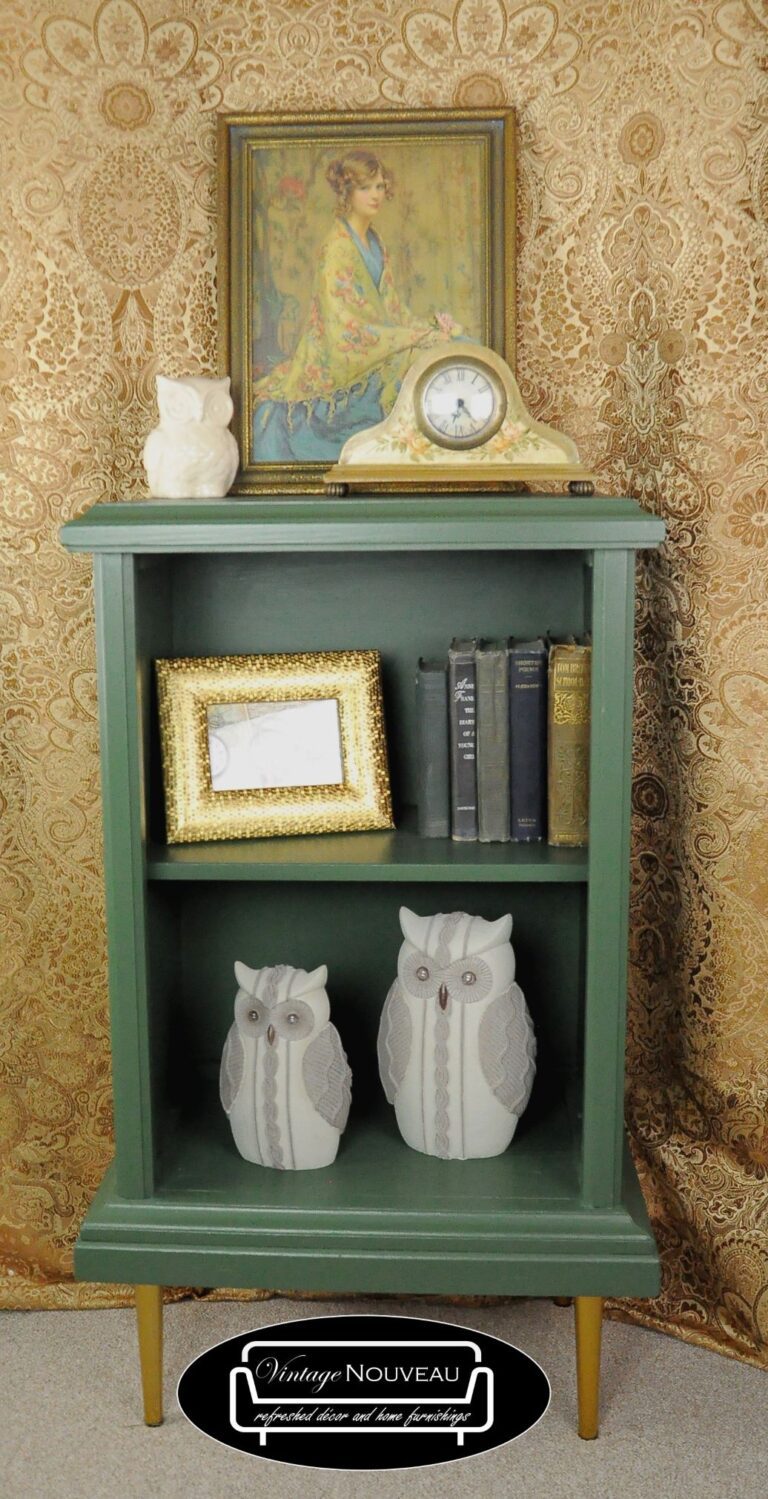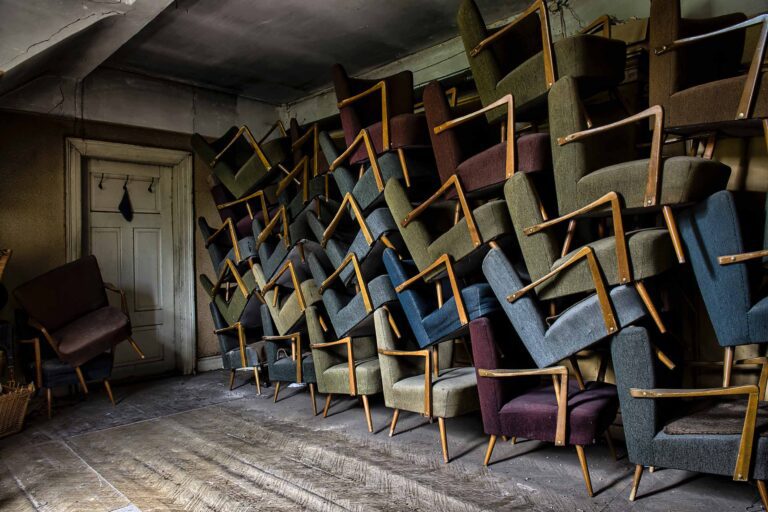Whether you’re a beginner furniture flipper or a seasoned one, you have likely experienced Painter’s Block. Maybe you didn’t know what it was called or that it even had a name.
Painter’s block is when your brain says, nope, I’m not working, and I refuse to come up with creative ideas to help you transform this fantastic piece of furniture. Or it shows up as procrastination, maybe outright defiance – stopping you from even working on a piece.

Have you had times when you are unable to paint? Not due to external factors, but because you can’t find the will?
I am not a psychologist, but I have identified six common mental blocks and behaviours that can lead to painter’s block. Let’s look at the types of painter’s block and examine ways to overcome them.
1. Starting too big
The first type of painter’s block you may experience is starting too big. It can be daunting to develop a design if you have selected a large, ornate piece, possibly older or even antique. What if you pick the wrong colour? How much paint will you need? Do you even want to paint it?
Or maybe a ‘free’ item shows up and you snag it – can you handle the repairs? Will you recoup your time and money if you sell it?

Start Small
For beginners, it is best to start with small, inexpensive pieces and work up to the large ones. Taking on a huge piece can overwhelm you causing a great big case of painter’s block. Often, there is much more work involved than many realize. You might get frustrated and give up. Instead, start small.
And if you refinish a small piece and aren’t happy with the results, or get stuck in the middle, it is much easier to start over than it would be on a big project.

2. Fear of Starting
Neophobia, or the fear of starting something new is a very common cause of painter’s block. It can be incredibly intimidating if you haven’t painted before and don’t know where to start. You have the piece and maybe even the paint and the tools, but you don’t want to mess it up. The thing is, if you don’t get started, you never will.
Just do it
The cure for fear is action. The biggest hurdle to painter’s block is getting started. Start by cleaning and prepping the piece, maybe putting a coat of paint on and seeing where it leads.
Often, for those pieces you intend to paint, a fresh coat of white primer can give you a better look at the piece and help you see past its former less-than-ideal finish.
It is hard to fail, but it is worse never to have tried to succeed.
Theodore Roosevelt
3. Too Indecisive
Once you pass that initial starting painter’s block, you must take the next step and choose a path.
Here, some people become riddled with indecision and indecision can cripple creativity. There are so many options, and we are afraid to start because we don’t know what style or colour will look best or how to choose. Some people are good at looking at a piece and executing the vision, but you don’t have to follow a plan. Lots of my pieces have taken me places I didn’t expect to go.
Find Inspiration
If you can’t decide or develop a plan, look for inspiration on social media sites. Sites like Instagram, Pinterest, or Facebook groups overflow with images of painted pieces. You will get tons of ideas from these sites, but don’t let this overwhelm you.
Look Around You
Start closer to home. If you plan to keep the piece, you should style the new piece to match your existing décor.
While I love embracing my inner artist, remember that creating a trendy piece for a traditional home will make the piece feel off. You don’t have to refinish furniture to suit your home, however. You can sell the piece, or you might redecorate the area because you love the new look.
Get in the Groove
After doing a few pieces, you will notice you prefer a particular style or technique and get into your groove and it will become easier to be inspired. I tend towards colour.
Rarely do I do a basic white piece of furniture. Some people are uncomfortable with colour and prefer to paint in neutral tones. Likely because neutrals sell faster because they suit a wider range of tastes.
You don’t have to create pieces that suit your own home if you sell them. I refinish in a wide range of styles, from traditional to MCM, to fun and whimsical, but almost always with colour.
If you are selling your furniture or décor pieces, you can try and fit a specific mould of what sells best. But a word of advice, if that style doesn’t suit you, then find your path. People will find you. The more eclectic your style, the longer it may take to develop a following, but stick with what you love so you won’t get bored.
4. Striving for Perfection
Maybe you have started painting, but now you feel like you aren’t getting the desired results. Sometimes our finished product doesn’t turn out exactly as hoped. We give up. We say, “forget it; this isn’t working.” Instead of letting this type of painter’s block get the best of you, try the following.
Give the Process a Chance
Don’t look at a piece before it is complete and say you hate it. At a minimum, apply two coats of paint and maybe add details like a transfer, new hardware, glaze, wax, or metallic highlights. Sometimes, you need to tweak it a little, and it will all come together. You will be amazed at how quickly a piece can go from an ugly duckling to a beautiful swan.
Start Over
One great thing about paint is that it is very forgiving. If you are unhappy with the final result and as long as you have followed the proper preparation and painting techniques, it is often a matter of painting over top of your work.
*If you apply wax, it will need to be removed before repainting unless it is water-based wax (the product needs to say this specifically).
What's the Worst That Could Happen?
Worst case scenario, you have to start over. In the best-case scenario, you learn a new technique you love.
Be brave and try something new. Don’t worry about every brushstroke or uneven line. I work hard on my piece to make it as lovely as possible, but in the end, it is a hand-painted, vintage/used piece that will never be perfect.
Compulsive Personalities
For those with compulsive personalities, like perfectionists, painter’s block can be very real. Stepping outside of your comfort zone and embracing imperfection can help you let go of something that may control your life. As I said, I am not a psychologist; I just know it helps to let go of limiting behaviour when possible.
However, I encourage furniture refinishers to hold themselves to a high standard because it can affect your business if you do too sloppy of a job. Just don’t let it ruin your day or drive you mad obsessing over every little dust nib or brushstroke.
“Have no fear of perfection. You’ll never reach it.”
Salvador Dali
5. Fear of Failure or Imposter Syndrome
Fear of failure, or atychiphobia, is another form of painter’s block. It is when you feel you aren’t good enough. You feel like others will judge you negatively if you try something you have never done before. You compare yourself to those with more experience than you and feel you will never measure up. You may start a piece and feel it isn’t good enough or doesn’t measure up. Maybe you question yourself so much that you won’t even start.
And even those who achieve success are vulnerable to this form of painter’s block. Imposter Syndrome is a very similar psychological block – you feel you don’t deserve your success even when it is obvious to others that you do.
I failed on my way to success.
Thomas Edison Tweet
Fake It Till You Make It
Look, everyone has to start somewhere. Don’t give up on yourself before you even try. The adage “practise makes perfect” will help you develop your style. It is gratifying to try something that scares you and then do it well.
Overcoming internal insecurities takes time. Be sure to acknowledge the challenges you have faced and overcome. Give yourself a pat on the back.
Unfortunately, social media can be harsh and there will always be those who want to bring others down. Do your best to ignore the negative Nellies and haters.
Don't be an Actual Imposter
A word of advice. Don’t be an actual imposter. Don’t copy someone’s piece exactly; instead, use it as inspiration. While imitation is the sincerest form of flattery, it can get you into some hot water with that artist.
Give credit where credit is due. Give them a shout-out if you post on social media. They will be thrilled, and it will help create a network of artists. Copy the artist’s technique, not their piece.
6. Hoarding
I covered this under the Top Eight Mistakes a Beginner Painter Makes; however, it applies here. Buying too much furniture to refinish can cause painter’s block. The overwhelming number of choices and crowded work areas can inhibit your creative flow.

Don’t feel you need to buy every good deal that comes along. Be selective, and choose pieces that fit your style. Also, not every piece is worth redoing because you may put in more time and materials than it’s worth, leading to a loss rather than a profit.
*Hoarding can be a serious mental challenge and this post is not meant to detract from how serious it can become. I refer to hoarding in a lighter way – and I just want you to consider each purchase in a meaningful way.
Summary
Sometimes we need to get out of our heads. Let go of whatever voice is saying we aren’t good enough, we will make the wrong choice, or it will never meet our standards. There is nothing more gratifying than succeeding where we thought we would fail.
The biggest way to break your painter’s block is to take decisive, intentional action. Don’t buy every piece you can find and overwhelm yourself. And when you do find a piece, take action and get started. After you fake it for a while, you will soon find you are actually creating some really awesome pieces!
One Last Bit of Advice on This
No one says you need to be perfect or find the exact colour or style that suits everyone. Even if there are people who say it, it doesn’t mean they are right.
This article covered the voices in our heads, but you will also need to overcome listening to the negative Nellies out there that want to bring someone down to feed their insecurities. The more experience you gain, the more confidence you will have as you create better and better pieces.
Ready to Learn?
Want to learn the skills professional furniture refinishers need to know? From Introductory to Intermediate to Advanced, the Skills bundle covers all of the skills you will need. The All-Access bundle includes the must-take Business Management course if you want to make money flipping furniture.





